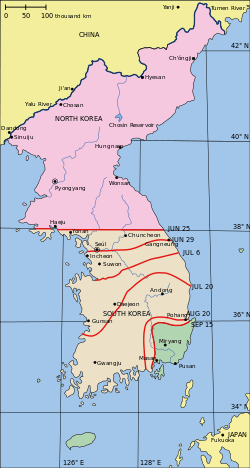Interior lines
Interior lines[lower-alpha 1] as opposed to exterior lines are two of a number of Military terms in a category, derived from the generic term line of operation, also line of movement.[1] Commonly used to illustrate, describe, analyze, etc. the various possible routes (lines) of logistics, supply, recon, approach, attack, evasion, manouvre, retreat...(operation) of armed forces. Interior line strategies are based on the fact that lines of movement and communication within an enclosed area are shorter and safer than those on the outside. As the area held by a defensive force shrinks, the advantages held by defensive force increase.[2][3]
Skillful and comprehensive application of interior line tactics can for a partially surrounded, hard pressed combat force provide vital breathing space, greatly reduce time, effort, security and secrecy of resupplies and redeployment and decrease the number of casualties. Once employed and pressed on, the resulting effects might accumulate. They will, however, have a great impact on morale and eventually prove decisive, as according to Napoleon Bonaparte: "in war morale forces are to physic three to one".[4][5]
Tactic


In the context of battlefield tactics, it allows more rapid concentration of resources (firepower and manpower) and so affords greater tactical flexibility. The resources are ideally brought to bear at a point where the adversary is not able to quickly respond, because of their longer external lines:
- At the Battle of Dyrrhachium (48 BC), the numerically superior Optimates, led by Gnaeus Pompeius Magnus, defeated the more battle-hardened Populares, led by Gaius Julius Caesar, when Caesar attempted to encircle them.
- During the Battles of Lexington and Concord, Brigadier General Hugh Percy utilized interior lines during the British retreat, as his men were often surrounded by militia.
- At the Battle of Jena-Auerstedt, Louis Nicolas Davout employed interior lines to defeat the main Prussian army.
- At the Battle of Wagram, the French under Napoleon I defeated the Austrians by acquiring interior lines and achieving local numerical superiority.
- George Gordon Meade used it against Robert E. Lee at the Battle of Gettysburg in 1863.[6]
Strategy
As a strategy, it is commonly employed to cut armies off from reinforcements and supplies, or prevent allies from uniting their forces. That usually allows for an adversary that may not be numerically superior to gain a numerical superiority over an adversary in a given locality, which increases the chances of overpowering an enemy and defeating it. By extension, in overpowering an enemy, an adversary hopes to demoralize it to a sufficient degree to bring it to political terms.
Examples
- At the Battle of Montenotte, the First French Republic under Napoleon defeated the Austrians and destroyed an entire corps, thereby destroying the link between the Austrians and their allies Kingdom of Sardinia. As a result of the victory, the Sardinians were separated from Austria and were unable to defeat the French or rejoin the Austrians. They eventually sued for peace.
- Frederick the Great's operational strategy, in his prosecution of the Seven Years' War against the separate armies of the French, the Russians and the Austrians, can be considered an example of the advantage of interior lines in warfare.
- It also gave the Reds a distinct advantage over the Whites in the Russian Civil War.
- General Robert E. Lee used the strategy during the Battle of Antietam during the American Civil War in 1862.[7]
- Though the Pusan Perimeter (Korea, 1950) was not an intentional strategy, the concentration of UN forces within the Perimeter allowed quick movement of supplies and reinforcements via internal lines.
See also
Notes
- Footnotes
- a term invented by 19th century Swiss-French officer and prominent author Antoine-Henri Jomini
References
- Michael D. Lundy (December 6, 2017). "Operations, chapter 5 - Passage of lines" (PDF). US Army. Retrieved May 4, 2020.
- William O'Connor Morris (1895). Moltke a biographical and critical study. Рипол Классик. pp. 85–. ISBN 978-5-87074-092-8.
- Alfred Higgins Burne (1946). Strategy as Exemplified in the Second World War: A Strategical Examination of the Land Operations. CUP Archive. pp. 17–. GGKEY:7F20S7AZG5P.
- A General Biographical Dictionary: Comprising a Summary Account of the Most Distinguished Persons of All Ages, Nations, and Professions, Including More Than One Thousand Articles of American Biography ... A.V. Blake. 1845. pp. 1001–.
- David T. Zabecki (27 September 2006). The German 1918 Offensives: A Case Study in The Operational Level of War. Routledge. pp. 66–. ISBN 978-1-134-25224-4.
- Kent Masterson Brown, Esq. (1 August 2011). Retreat from Gettysburg: Lee, Logistics, and the Pennsylvania Campaign. UNC Press Books. pp. 44–. ISBN 978-0-8078-6942-0.
- Kevin Dougherty (6 March 2015). The Vicksburg Campaign: Strategy, Battles and Key Figures. McFarland. pp. 107–. ISBN 978-1-4766-1993-4.